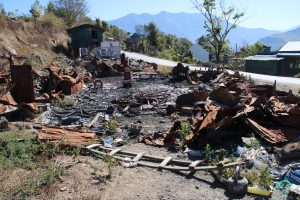Burned, bombed, and abandoned villages have become a common sight across Myanmar since the military coup of February 1, 2021, with regions that are at the vanguard of the anti-junta resistance suffering more than other areas of the country.
In the course of my travels between January and March, I noticed that while only a few houses had been torched in the two villages that I visited in Chin State and Sagaing Region, which are among the worst affected places in Myanmar in the continuing unrest or “revolution” against the country’s military-established State Administration Council (SAC), there are reports of villages in other regions that have been completely burned down.
According to a non-governmental organization, Data For Myanmar, the number of houses burned by the junta and its affiliated organizations between May 1, 2021 and May 31, 2023 was approximately 70,324, out of which Sagaing Region alone accounted for 53,816. Some 1,637 houses were burned in Chin State.
The Diplomat visited two villages, Natchaung at Kalay in Sagaing Region on January 24 and Haimual-New Haimual in Chin State on January 14. These villages bore the brunt of military raids. Around 30 houses were burned of a total of 500 houses at Natchaung, while 22 houses were burned in Haimual-New Haimual, which is located about 5 kilometers from the border with India’s state, including six that were partially burned.
Interviews and conversations with resistance fighters and residents of these villages, who are now staying in camps in Myanmar and India, reveal that there was no fixed pattern to the military attacks. They said that the nature of the raids and their duration depended upon the location of the targeted settlement, and the availability of resources and information with the regime troops.
Rebuilding Homes from the Ashes
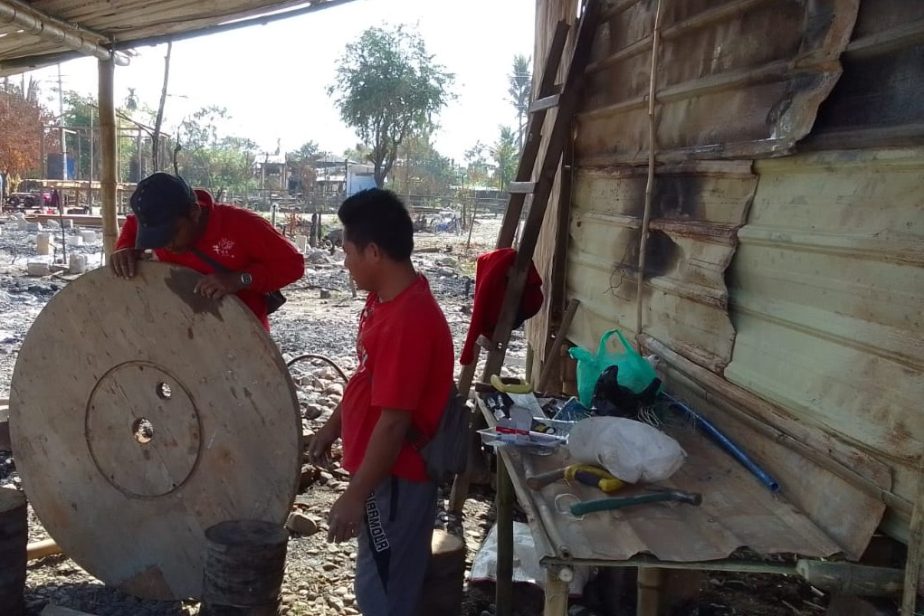
Two men making efforts to rebuild their burned house at Natchaung in Myanmar’s Sagaing Region. Photo by Rajeev Bhattacharyya
Among the first scenes that greeted me and the three-member team of resistance fighters that included a translator at Natchaung was of two people rummaging through what was their home until January last year, when regime troops attacked the village and razed a number of buildings. Their residence was an easy target as it was only about 100 meters from the main road that links Letpanchaung with Kalamyo city. Residents were able to escape to safety in the nick of time when they saw houses being set ablaze.
The two people were collecting items that had not been destroyed by the troops. We stopped, watched them for a few seconds, and decided to speak to them. The two men were brothers who had relocated with their families to a relative’s home in a village about 8 kilometers away in north Kalay. While one brother was a farmer, the other was a petty trader who supplied commodities to the market at Letpanchaung.
Since the house they were taking shelter in was not big enough to accommodate so many people over a long period, the brothers decided to rebuild their house at Natchaung. They decided that the women and children would continue to stay at their relative’s house until the other residents also returned to the village. They were confident that they would be able to rebuild their home as the troops had not raided the village again. We saw a middle-aged man at another site in the same village who was engaged in a similar activity to rebuild his burned home.
Scavenging for Usable Commodities
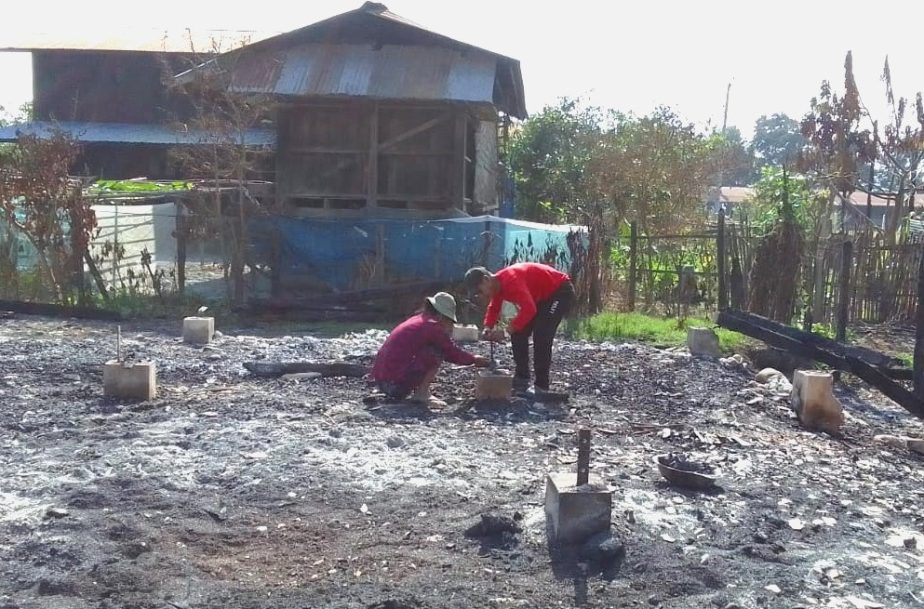
Residents of Natchaung village in Myanmar’s Sagaing Region gathering items to be used for a new house at a different location. Photo by Rajeev Bhattacharyya
At Natchaung, some residents had decided not to return to their burned homes immediately. As we moved deeper into the village, we saw a father and son trying to remove an iron clamp from a pillar. Unlike the two men who were rummaging among the remains of their house to rebuild another at the same site, these two were gathering items that could be utilized for building a new house at a different location.
The father, who was a farmer, said that they had been allocated a small plot for a house in another village some 16 kilometers away which was near the jungles. “We are five families from Natchaung in that village. Some of these families have already constructed their houses on plots given to them in this village. We have decided to follow in their footsteps since returning to our native village is fraught with danger,” he said in a hushed tone. This was their third visit to their native village in three weeks to gather whatever they could salvage from the burned house.
And how successful was the mission? “Not much because ours was among those houses that were completely charred. In all probability, they (regime forces) assumed that members of our family were active members of the People’s Democratic Forces (PDFs), the anti-junta resistance groups,” the father said, adding that he “managed to recover some iron items, including door locks, semi-burned tin sheets and a partially damaged bicycle.” He went to the task of uprooting the clamp. We watched him trying to put the pieces of his life back together for some more time and decided not to disturb him with more questions.
The Dog that Refused to Relocate to a Refugee Camp
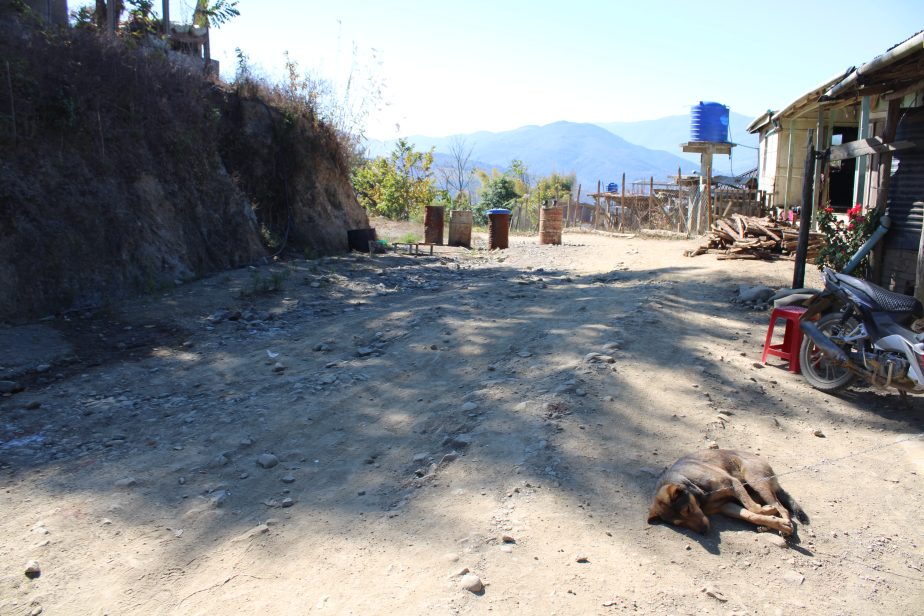
A dog at Haimul in Myanmar’s Chin State that returned home from a refugee camp in India. Photo by Rajeev Bhattacharyya
Haimual and New Haimual are two contiguous villages in Myanmar’s Chin State that lie across the river Tiao, which serves as the boundary between Myanmar and India. In January of last year, junta troops carried out a raid here and burned houses located along or near the highway on the western flank of the settlement. Two teenagers of one family, a boy and a girl, were whisked away by the marauding army. They were found dead on the banks of the Tiao the next day. Fearing more attacks, the entire village except the resistance squad named the Mountain Eagle Defense Force (MEDF) relocated to refugee camps at Zokhawthar across the river.
At refugee camps in Zokhawthar and the IDP camps at Salen village in Myanmar’s Chin State, I noticed that many families had brought their pets along with them. However, at Haimual, I saw a dog that was chained all day and shifted to a room only in the evening when its master, a functionary of the MEDF, returned. I did not see any other dogs in the abandoned village during the two days I spent there.
So, what was the story of the lone dog?
“Like the other residents of this village, my entire family relocated to Zokhawthar. They took our pet dog with them to the camp,” the MEDF fighter explained. “But after two days, the dog crossed the river and returned to the village. The reason was that I stayed behind with other functionaries of our resistance group to defend the village from further raids by the army,” he said. “I used to feed the dog every day and it has remained attached to me.”
And why was it chained the whole day? An MEDF functionary died on the outskirts of the village on January 10, when he accidentally stepped on a landmine. There remains a danger that the dog could meet the same fate, stepping on a landmine planted around the village and especially on the route traversed by the regime troops.
Smashing with Clubs and Rods
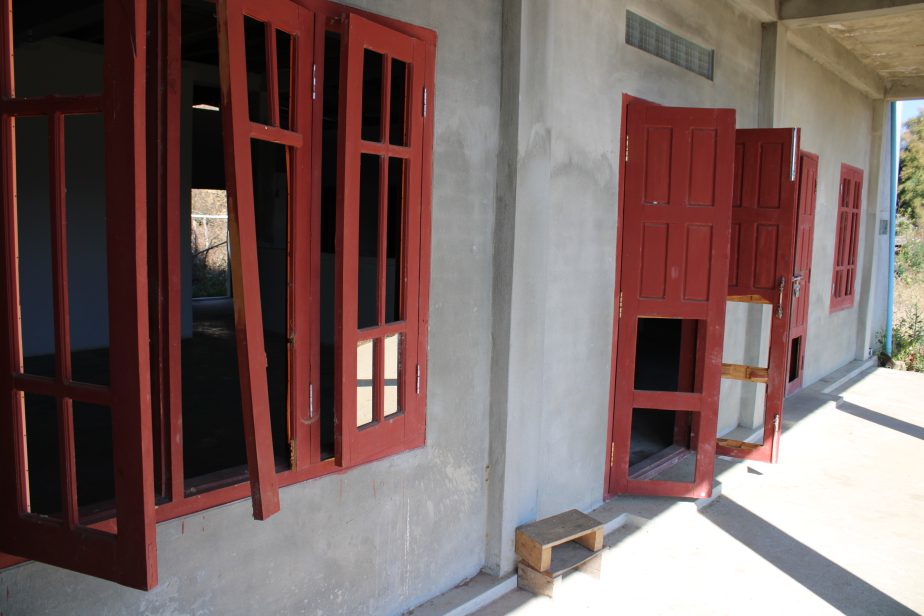
Broken windows and doors in Haimual village in Myanmar’s Chin State. Photo by Rajeev Bhattacharyya
Residents at Natchaung and Haimual-New Haimual said that regime forces employed a variety of tactics to destroy houses. A resident of Natchaung whose house was not burned pointed out that the raiding squad did not carry fuel with them to torch the houses. They took fuel from the village, which was different from what happened at Haimual-New Haimual, where soldiers carried “jerry cans” of fuel to pour on houses before setting them on fire.
“The quantity of fuel, which was possibly diesel, was not enough to burn too many houses. So, after emptying the cans, they picked up clubs and rods to smash everything in the houses that were targeted, including window panes, decorative items and kitchen utensils,” said an elderly man who had relocated with his entire family of six to the camp in Zokhawthar.
In Haimual-New Haimual, we saw many houses with broken doors and windows, damaged furniture, tables, and electrical equipment. These smashed objects were seen in houses that were completely charred and also in some that were not burned, indicating that the troops had barged in to destroy as many items as possible during the time they stayed in the village for the operation. A functionary of the MEDF alleged that many valuable items were also thrown into the fires from the houses that were targeted.
“Loot First, Then Burn the Paddy and Everything Else Possible”
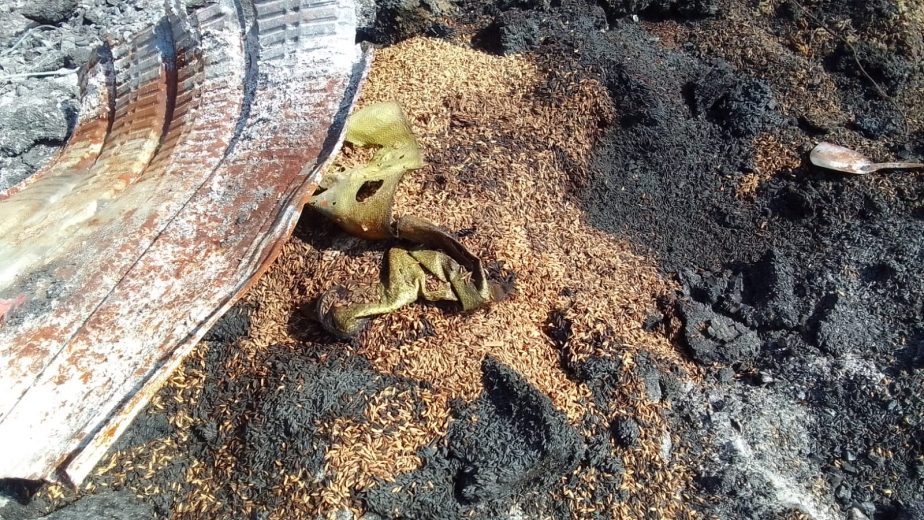
Burned paddy at a house in Natchaung in Myanmar’s Saging Region. Photo by Rajeev Bhattacharyya
In both Natchaung and Haimual-New Haimual, troops also burned edible items in houses. They looted items from houses – a trend that has surfaced in other parts of the country – before setting them alight. A senior member of the Pa Ka Pha (Local Defense Force) claimed that they focused their attention on those houses whose inhabitants were actively engaged with the resistance groups.
We noted three houses where the granaries were undamaged, but the stock of paddy had been singed along with the attached pieces of timber. It is possible that the soldiers wanted to ensure that residents would not be able to carry the food stock to the places where they relocated.
“They (military personnel) were in a hurry to burn the houses at the earliest since there was a possibility of attack by the resistance fighters. Their credo is to loot first, then burn the paddy and everything else possible. And, of course, in the process, they would kill whosoever they spot during the operation,” a resident of Letpanchaung, who accompanied us to the village said.
Mentally Disabled Person Burned Alive
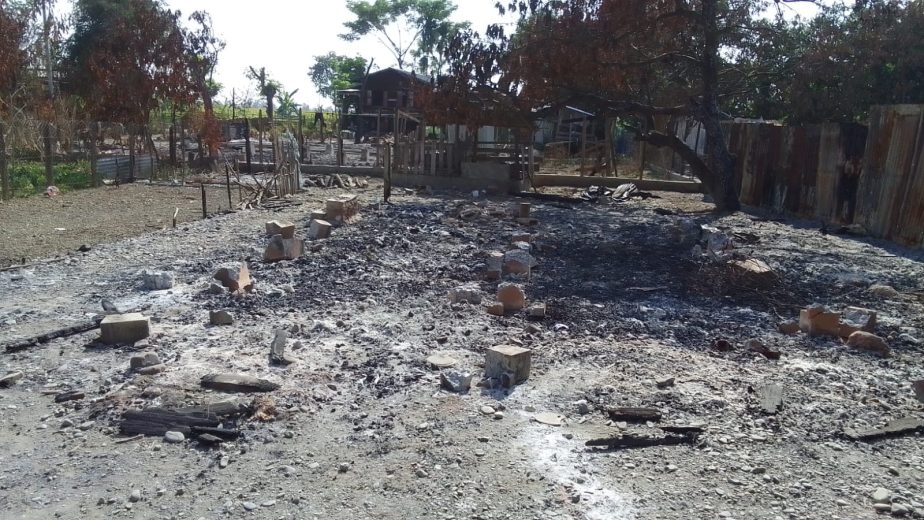
The house at Natchaung village in Myanmar’s Sagaing Region where a mentally challenged person was burned alive. Photo by Rajeev Bhattacharyya
A few residents of Haimual-New Haimual who had relocated to refugee camps in Mizoram claimed that regime forces were accompanied by a member of a pro-junta militia, who hailed from a place near Tedim located about 80 kilometers east of these settlements and provided them with information about the village. In the case of Natchaung, some Pa Ka Pha functionaries believe that information about specific houses was provided by the Pyu Saw Htee (pro-junta militia) from a village located in Kalay.
Sometimes the information provided to the regime troops was false.
This happened with one house at Natchaung, where a mentally disabled person in his early sixties lived with his son who was not attached to any resistance group. Many residents had escaped from the village after resistance fighters alerted them about the impending attack; they were warned about an hour ahead of the arrival of the soldiers.
Pa Ka Pha functionaries claimed that the mentally disabled person was left behind as his son had not returned from a visit to another village on the previous day. When regime troops attacked the house, the man did not realize that it was set on fire. “In all likelihood, he was sleeping. We also do not know the actual sequence of events that led to his death. But we found his charred body in the bedroom the next day,” a member of the Pa Ka Pha said. The man was buried a day later.
Damaged House of Resistance Functionary
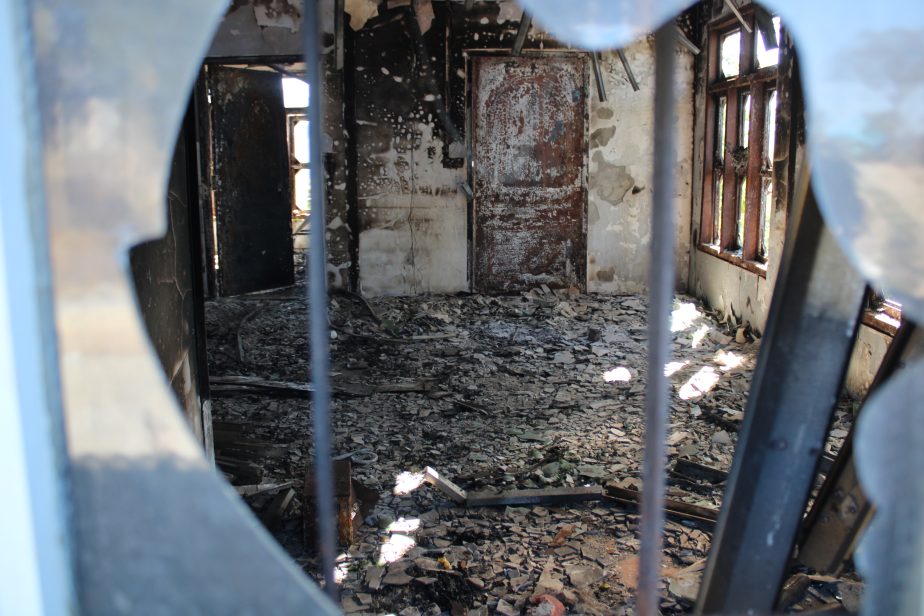
The damaged house of a functionary belonging to a resistance group at Haimual village in Myanmar’s Chin State. Photo by Rajeev Bhattacharyya
The military puts in more effort to destroy houses belonging to functionaries of resistance groups. In the raid on Haimual-New Haimual, at least seven such houses were burned, of which three were reduced to ashes.
The raiding team held 12 residents of Haimul-New Haimul hostage, as a shield against attacks by resistance groups. While others in the village somehow dashed out before the operations began, the residents held hostage witnessed a tragedy unfold before their eyes. A house that belonged to a MEDF resistance fighter was set on fire was just 50 meters from where the 12-member group was herded at gunpoint, near the highway on the western flank of the twin villages.
A farmer in his late twenties was among the hostages. He subsequently relocated to a refugee camp in Zokhawthar. He recalled that the house was not completely gutted as the fuel carried by the soldiers was exhausted. “So, they (military personnel) started smashing the glass on the window with rods and tree branches and then they barged in to destroy all the unburned items including wooden things and electrical appliances,” he said. “This was to send a message to all the residents about what lay ahead for them if they engaged in anti-junta activities.”













